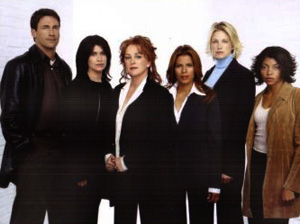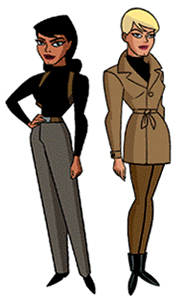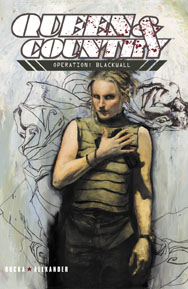Comics /
Cult Favorite
Women in Comics
By Philip Schweier
October 31, 2005 - 09:13
First of all, let me offer a disclaimer by saying that I grew up with five – count ‘em FIVE – older sisters. Male chauvinism had no place in our household.
That having been said, I must say I am troubled by the roles of women in comics. Ever since Jeanette Kahn took over the reins at DC in the mid 1970s, more girls, and eventually women, have gone from fans to professionals. Maybe I’m impatient, but it hasn’t happened fast enough. It’s foolish for any industry to alienate half of its potential audience simply due to gender. Ultimately, I don’t care who creates comics, regardless of race, color or creed, as long as they are entertaining and enjoyable.
“It is abysmal, but it's a boy's hobby,” Axel Alonzo, an editor at Marvel, told a group of art students in April, 2005. “I think there've been improvements, perhaps, but at the end of the day, when I think of the Marvel staff, we have no senior female editors, one associate and two assistant editors out of a staff of about 17."
Because it is still a male-dominated career, it often happens that men are called on to write women characters. Well, why not? White people write ethnic characters, as well as aliens and other socio-ethnic groups in which the writer does not fit in real life.
One might argue that an author’s gender shouldn’t matter regarding what they write. I agree, and certainly don’t advocate men write only male characters, and women write only female. Unfortunately, lesser authors in a variety of fields illustrate their shortcomings when they fall into the trap of clichés and stereotypes. Such two-dimensional portrayals of women are usually reserved for the cable channel Lifetime.
Despite its efforts to market itself as “television for women,” the cable network has a reputation of showing women as victims, using tiresome formulas in its made-for-TV movies. Newscaster Connie Selleca is stalked by newspaper reporter Jack Scalia, or Melissa Gilbert is the abused wife of politician Tim Matheson. Granted, in the end, the women win out, but a five-minute victory is small compensation for almost two hours of fear, intimidation and humiliation.
 |
Lifetime’s original series
The Division depicts a team of San Francisco cops. Bonnie Bedelia portrays a tough, no-nonsense captain (because we all know for a woman to achieve a position of authority, she can never crack a smile). A Hispanic inspector, played by Lisa Vidal, is also a single mom, juggling her career and family (as though men don’t). Another, Tracey Needham, has marital problems, while Nancy McKeon plays a self-destructive cop whose personal life suffers from alcohol abuse and bad relationships. An African-American inspector, played by Lela Rochon, is the inexperienced officer who is out to prove herself.
What I see here is no middle ground, but extremes of character, nested in extremely balanced racial mix. Authority opposite inexperience, sweet and innocent opposite dark and destructive. But of course, the clichés don’t stop with the women characters. The detectives seem to have a disproportionate number of WASP male criminals, with very few street punks of any kind of ethnicity.
Police work is often depicted as a man’s world, and a female cop is often required to prove herself somehow. It often happens that in order for a female character to be presented on equal footing with a male, she must be a “one of the boys.” According to the Internet Movie Database,
Division creator Deborah Joy LeVine had wanted to make one of the regular characters a lesbian cop but the network refused, perhaps rightfully so. I’m all for equality for gays as well, but the message I hear in this instance is that, “In order for a female to meet the challenge of a traditionally male environment, she must sacrifice her femininity.”
To play such a socio-ethnic card to construct a character is hackneyed. Two examples of that in comics would be Maggie Sawyer, of the Metropolis Major Crimes Unit, and Reneé Montoya of the Gotham City Police Department. Both have been depicted as gay. Not inaccurate, as I’m sure that there are lesbian cops, just as there are gay male cops, and lesbian doctors and teachers and chefs and any other occupation you can name.
Such literary short-cuts show very little originality and demonstrate minimal effort or ability on the part of the writer. For a stripper's sexuality to be a dominant character trait would be a valid portrayal. However, for a woman police officer's orientation to be such a significant element seems like dodging the real task: creating a bonafide three-dimensional personality.
A genuinely talented writer ought to find this no more difficult than writing a child, or an Asian, or an alien, or some uncommon role. Greg Rucka, who has written
Gotham Central featuring Det. Reneé Montoya, has also crafted a number of strong feminine female characters, from the classic Wonder Woman to his own Tara Chace in
Queen & Country.
Despite a writer’s approach, how a woman is portrayed in comics can be divided into two categories: how the character is written, and how the character is drawn. Often, comics artists will indulge in their adolescent fantasies by drawing every female as some sort of pin-up model. While we may all enjoy a little eye candy, it gets tiresome to see the same attractive people hanging out with other attractive people. We see enough of that on
O.C., One Tree Hill, and all the other teen soaps seen on third-tier networks.
Being a guy, I have no objection, but being a comic reader, I’d prefer a broader spectrum of women in comics. Amanda Waller is indicative of the token “non-super model” female. Such every day folk often exhibit a more rounded and interesting personality than the often empty and vacuous “beautiful people.”
Truly well-crafted characters are multi-faceted beings whose personalities shine in multiple directions to varying degrees. Lois Lane may have started out as a plucky reporter, but after 60+ years, she’s evolved to the point where being a journalist is only one facet of her persona. She's also a daughter, a wife, and sometimes, as a reporter, she's saddled with dull stories, like city council meetings and school lunch reform.
In some cases, a creator will substitute authority for any degree of true personality. Gene Roddenberry used his portrayal of the future to advance the women’s movement. In the original
Star Trek series, it was novel and daring. But by the time
the Next Generation had run its course, it had become old hat. Nearly every male Starfleet captain answered to a female admiral.
Everyone seems to have their own axe to grind, their own personal cause that they feel the need to hammer home in EVERY story they write, every film the direct, every comic book they create. Okay, we get it. It’s as though their thinking is “I can’t say it well, so I’ll say it often.”
I won’t begrudge anyone their personal politics, whether I agree with them or not. But I don’t feel it’s necessary to beat me over the head with their raison d’etre at every opportunity. They run the risk of turning it into an over-used parody.
Frankly I’ve had enough such stereotypes and clichés to last a Lifetime.•
Praise and adulation? Scorn and ridicule? Email me at philip@comicbookbin.com
Last Updated: March 3, 2025 - 20:40


